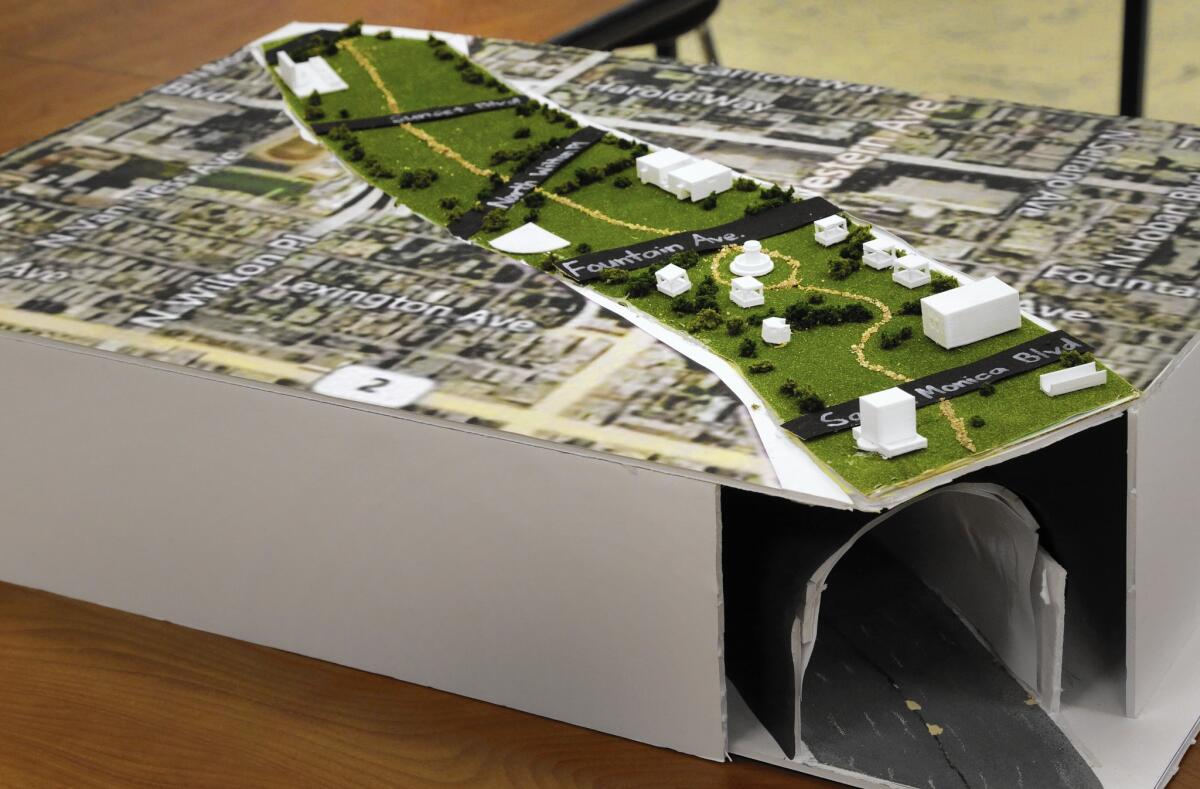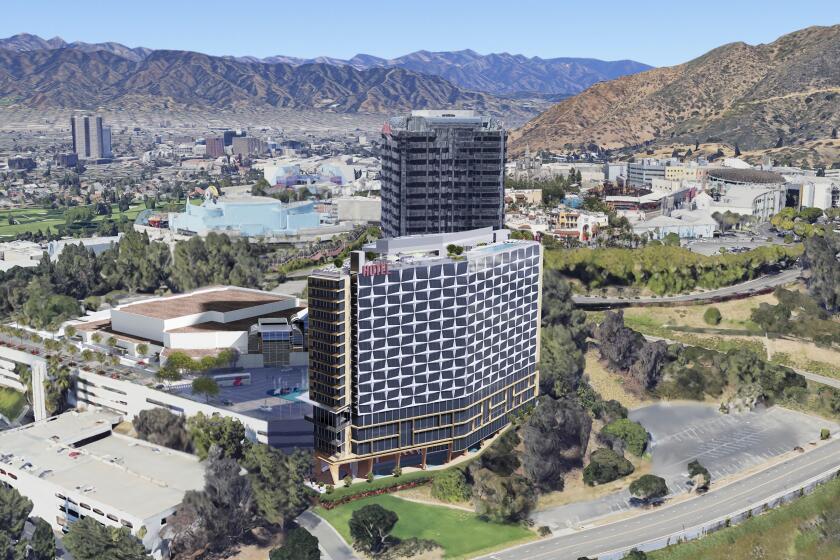STEM Academy students envision green space built atop 101 Freeway

- Share via
The STEM Academy of Hollywood is perched above eight lanes of traffic on the 101 Freeway. Its classroom windows offer the high school engineers a bird’s-eye view of some of Los Angeles’ most enduring woes.
Too many cars. Too much cement. A freeway system that slices through neighborhoods, leaving them uninviting to crisscross on foot.
It’s an ideal vantage point from which to dream about how to right some of those wrongs.
This year, some juniors at the L.A. Unified campus spent time brainstorming how best to design a park built right on top of the freeway.
They formed mock engineering companies — with project managers, budgets and deadlines — and modeled their ideas using 3-D printers and computer-aided design.
First-year teacher Katherine Simon, who came straight out of an engineering career, said she wanted the students to experience what it’s like to bid on a real project, from start to finish.
“It’s not always just about calculations or technical stuff,” she said. “It’s about teamwork. It’s about communication with themselves and with an audience. It’s about creativity, using new technology, using green technology.”
The academy is an L.A. Unified pilot school, which means it can operate with greater autonomy and more input from students, teachers and parents. STEM is an acronym for its core curriculum: science, technology, engineering and medicine.
The school’s aim is to offer a mix of rigorous academic and career-focused instruction, rich with real-world experiences. Through community partnerships, its students intern, volunteer and learn from guest speakers and field trips.
Finding such opportunities for students on the medical track has been easy, Principal Paul Hirsch said. The school is near a cluster of hospitals, and this year, 27 doctors at Kaiser Permanente mentored 27 STEM Academy juniors.
As for the engineering students, Hirsch said, a nonprofit called Friends of the Hollywood Central Park stepped in at just the right the time.
For nearly a decade, the group has been advocating to create much-needed green space in Hollywood by putting a cap over the freeway where the school is located.
Cars would travel, as they currently do, in lanes below street level. Above them would stretch a 38-acre, mile-long park, from just north of Hollywood Boulevard to Santa Monica Boulevard.
Putting green space on top of the traffic, the group says, would reunite a Hollywood split by the freeway more than half a century ago. It also would provide breathing room in a densely populated neighborhood where many residents — STEM students among them — live in apartments and lack outdoor space.
When the nonprofit said it would help the school in any way it could, Simon, 29, designed her curriculum around the park project.
First, she taught students basic civil engineering skills and theory. Then, she divided them into three design firms. Each got a formal Request for Proposals letter, inviting them to submit a park design.
This week, the teams presented their work to a panel that included nonprofit board members. The students dressed up for the occasion. Some of the girls wore ties.
“When we came up with this idea back in 2006, you were who we had in mind — the future of Hollywood,” Laurie Goldman, the nonprofit’s executive director, told them. “It’s for you and your families and your sisters and your children.”
The teams showed cellphone videos documenting their projects. They displayed models and screened animated flyovers of their park designs.
One team’s vision included a pizza shop shaped like a slice. Another had a bike shop, a skate park and an art gallery.
Each pushed its own environmental ideas: gray water and ways to reduce runoff; electrostatic precipitators to filter out air pollution generated on the freeway; solar panels, which one student explained could be a great deal because some companies offer free installation.
Terrance Mack, 17, got a little flustered when it was his turn to walk the judges through his team’s design, which ended up being declared the winner.
He ad-libbed, mentioning “supermarkets, dog parks, art museums, an amphitheater, a skate park and a lot of trees … yeah.
“I wish I could stop talking,” he said as the animation he had helped design continued to run.
When it was over, he said he preferred quiet to such performances and, if the park was built, “I’d probably go in and fall asleep on a tree.”
His teammate, 16-year-old Harrison Balmonte, who lives near what would be the park’s southern end, said it was intimidating to work on something real at first.
“Which makes it more enjoyable, more satisfying,” said teammate Raphael Calalo, 17, as they gazed proudly on their park model on display, looking a little like a curving, skinny green snake.
Follow City Beat @latimescitybeat on Twitter and at Los Angeles Times City Beat on Facebook.
More to Read
Sign up for Essential California
The most important California stories and recommendations in your inbox every morning.
You may occasionally receive promotional content from the Los Angeles Times.











